Report: Critical Evaluation of Evidence for Academic Enhancement
VerifiedAdded on 2020/07/23
|9
|2316
|110
Report
AI Summary
This report critically evaluates two research articles concerning the impact of stimulants on academic performance, addressing a case study involving a student named Wasim. The first article employs a qualitative approach, interviewing students to understand their experiences with prescription and psycho stimulants. The second article utilizes a quantitative approach to assess the relationship between non-medical use of prescription stimulants, executive functioning, and academic outcomes. The report analyzes the strengths and weaknesses of each article, highlighting sample size limitations and the use of different methodologies. It further discusses barriers to applying the evidence, such as generalizability and varying stimulant intake amounts, and aligns the research papers with PICO elements to determine their relevance to the central research question. The conclusion emphasizes the positive impact of stimulants on academic performance while acknowledging the limitations of the evidence presented.
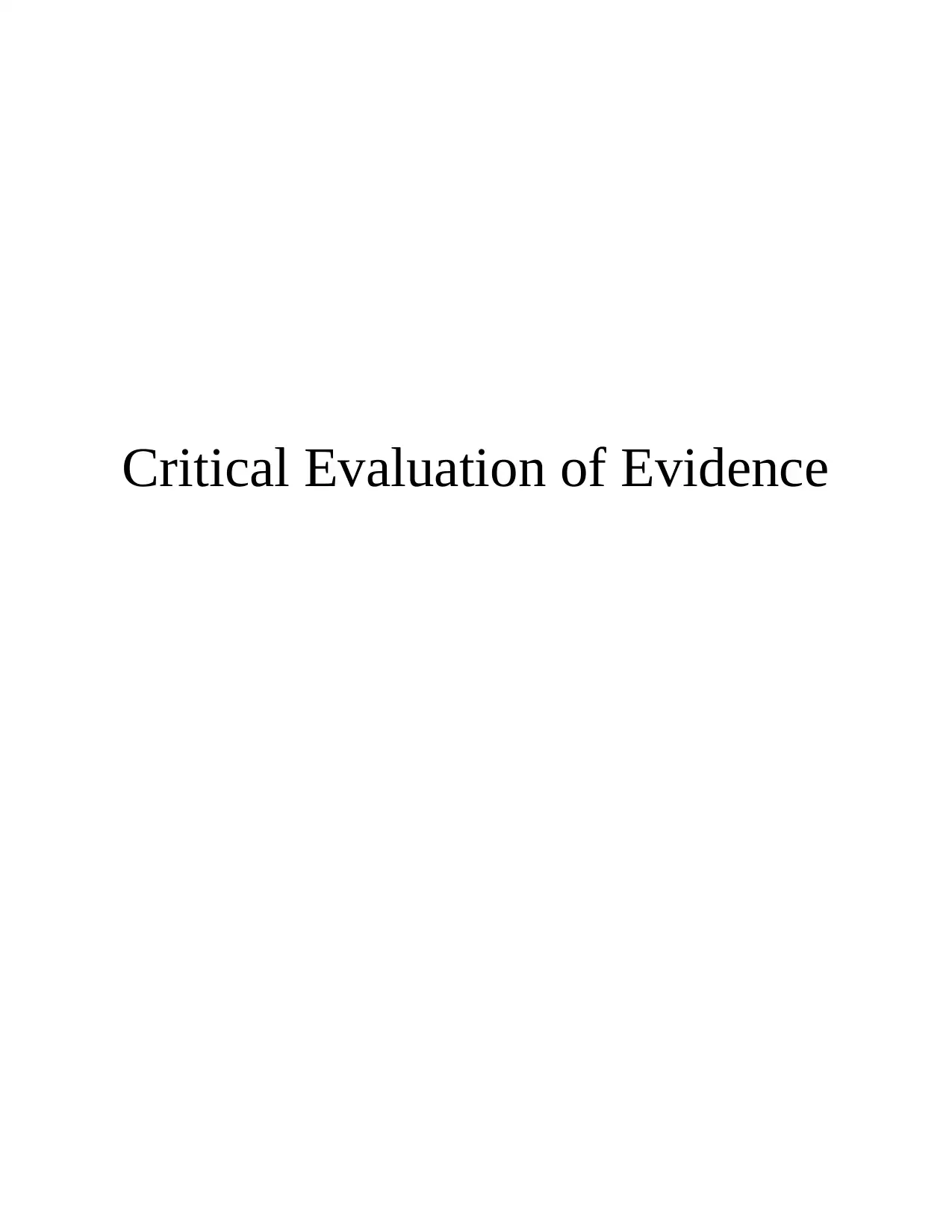
Critical Evaluation of Evidence
Paraphrase This Document
Need a fresh take? Get an instant paraphrase of this document with our AI Paraphraser
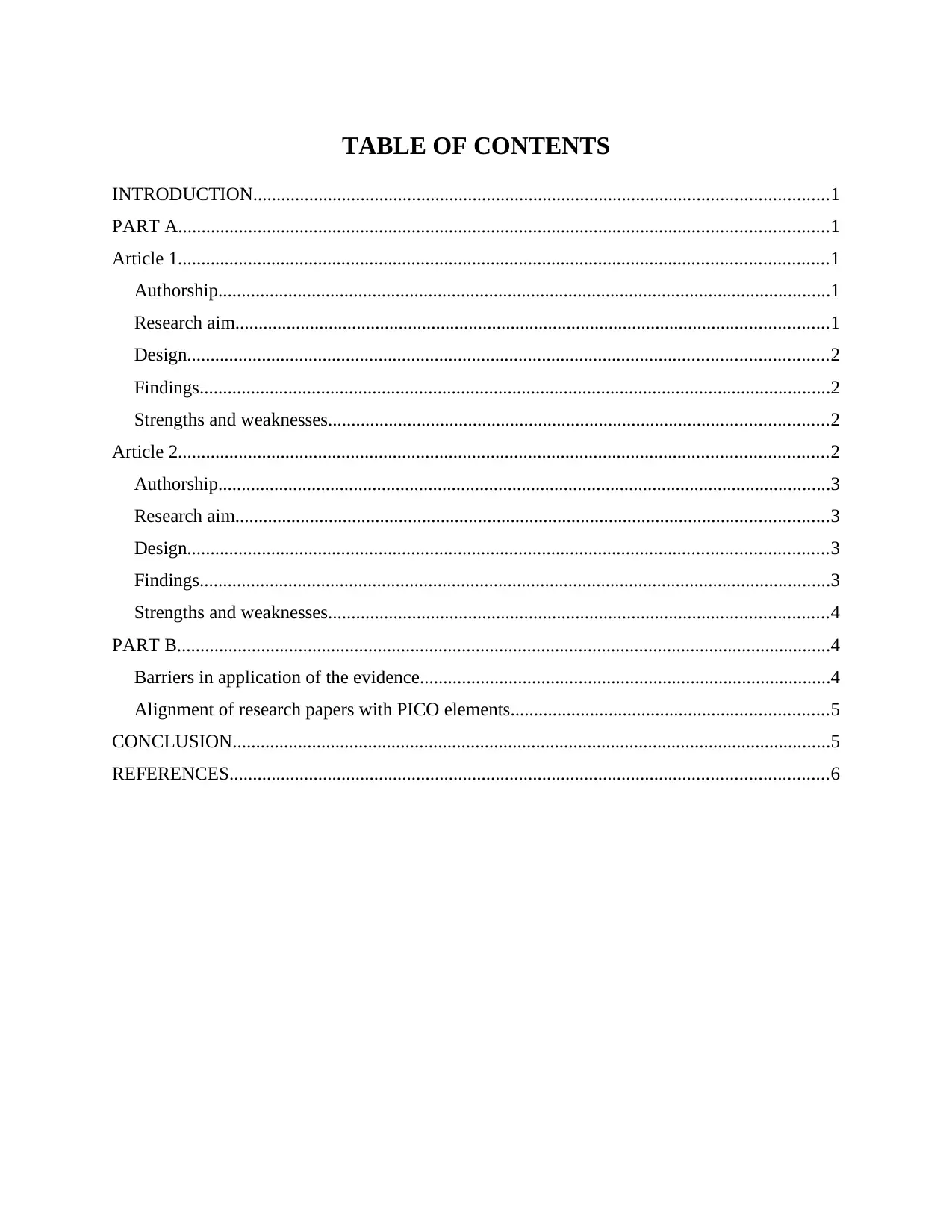
TABLE OF CONTENTS
INTRODUCTION...........................................................................................................................1
PART A...........................................................................................................................................1
Article 1...........................................................................................................................................1
Authorship...................................................................................................................................1
Research aim...............................................................................................................................1
Design.........................................................................................................................................2
Findings.......................................................................................................................................2
Strengths and weaknesses...........................................................................................................2
Article 2...........................................................................................................................................2
Authorship...................................................................................................................................3
Research aim...............................................................................................................................3
Design.........................................................................................................................................3
Findings.......................................................................................................................................3
Strengths and weaknesses...........................................................................................................4
PART B............................................................................................................................................4
Barriers in application of the evidence........................................................................................4
Alignment of research papers with PICO elements....................................................................5
CONCLUSION................................................................................................................................5
REFERENCES................................................................................................................................6
INTRODUCTION...........................................................................................................................1
PART A...........................................................................................................................................1
Article 1...........................................................................................................................................1
Authorship...................................................................................................................................1
Research aim...............................................................................................................................1
Design.........................................................................................................................................2
Findings.......................................................................................................................................2
Strengths and weaknesses...........................................................................................................2
Article 2...........................................................................................................................................2
Authorship...................................................................................................................................3
Research aim...............................................................................................................................3
Design.........................................................................................................................................3
Findings.......................................................................................................................................3
Strengths and weaknesses...........................................................................................................4
PART B............................................................................................................................................4
Barriers in application of the evidence........................................................................................4
Alignment of research papers with PICO elements....................................................................5
CONCLUSION................................................................................................................................5
REFERENCES................................................................................................................................6
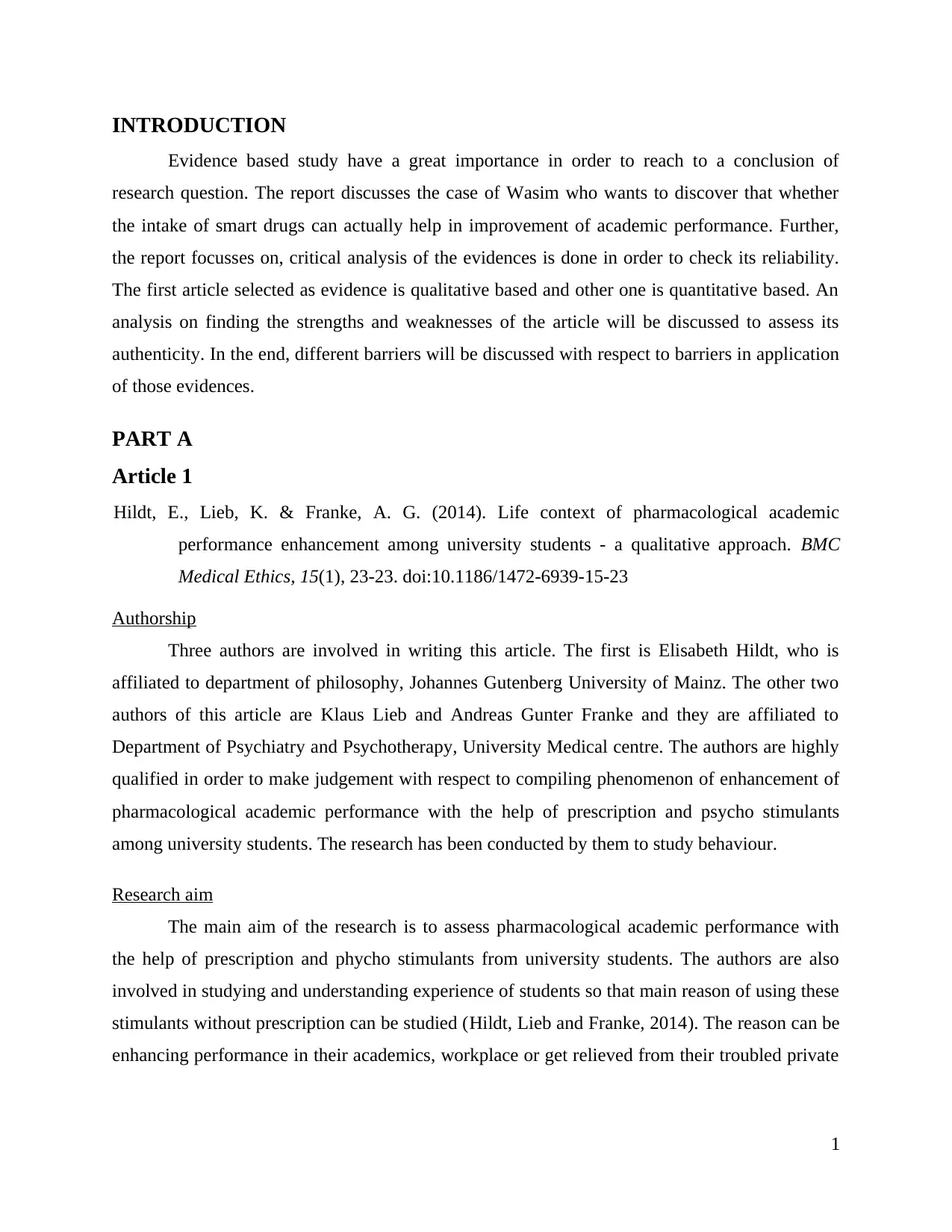
INTRODUCTION
Evidence based study have a great importance in order to reach to a conclusion of
research question. The report discusses the case of Wasim who wants to discover that whether
the intake of smart drugs can actually help in improvement of academic performance. Further,
the report focusses on, critical analysis of the evidences is done in order to check its reliability.
The first article selected as evidence is qualitative based and other one is quantitative based. An
analysis on finding the strengths and weaknesses of the article will be discussed to assess its
authenticity. In the end, different barriers will be discussed with respect to barriers in application
of those evidences.
PART A
Article 1
Hildt, E., Lieb, K. & Franke, A. G. (2014). Life context of pharmacological academic
performance enhancement among university students - a qualitative approach. BMC
Medical Ethics, 15(1), 23-23. doi:10.1186/1472-6939-15-23
Authorship
Three authors are involved in writing this article. The first is Elisabeth Hildt, who is
affiliated to department of philosophy, Johannes Gutenberg University of Mainz. The other two
authors of this article are Klaus Lieb and Andreas Gunter Franke and they are affiliated to
Department of Psychiatry and Psychotherapy, University Medical centre. The authors are highly
qualified in order to make judgement with respect to compiling phenomenon of enhancement of
pharmacological academic performance with the help of prescription and psycho stimulants
among university students. The research has been conducted by them to study behaviour.
Research aim
The main aim of the research is to assess pharmacological academic performance with
the help of prescription and phycho stimulants from university students. The authors are also
involved in studying and understanding experience of students so that main reason of using these
stimulants without prescription can be studied (Hildt, Lieb and Franke, 2014). The reason can be
enhancing performance in their academics, workplace or get relieved from their troubled private
1
Evidence based study have a great importance in order to reach to a conclusion of
research question. The report discusses the case of Wasim who wants to discover that whether
the intake of smart drugs can actually help in improvement of academic performance. Further,
the report focusses on, critical analysis of the evidences is done in order to check its reliability.
The first article selected as evidence is qualitative based and other one is quantitative based. An
analysis on finding the strengths and weaknesses of the article will be discussed to assess its
authenticity. In the end, different barriers will be discussed with respect to barriers in application
of those evidences.
PART A
Article 1
Hildt, E., Lieb, K. & Franke, A. G. (2014). Life context of pharmacological academic
performance enhancement among university students - a qualitative approach. BMC
Medical Ethics, 15(1), 23-23. doi:10.1186/1472-6939-15-23
Authorship
Three authors are involved in writing this article. The first is Elisabeth Hildt, who is
affiliated to department of philosophy, Johannes Gutenberg University of Mainz. The other two
authors of this article are Klaus Lieb and Andreas Gunter Franke and they are affiliated to
Department of Psychiatry and Psychotherapy, University Medical centre. The authors are highly
qualified in order to make judgement with respect to compiling phenomenon of enhancement of
pharmacological academic performance with the help of prescription and psycho stimulants
among university students. The research has been conducted by them to study behaviour.
Research aim
The main aim of the research is to assess pharmacological academic performance with
the help of prescription and phycho stimulants from university students. The authors are also
involved in studying and understanding experience of students so that main reason of using these
stimulants without prescription can be studied (Hildt, Lieb and Franke, 2014). The reason can be
enhancing performance in their academics, workplace or get relieved from their troubled private
1
⊘ This is a preview!⊘
Do you want full access?
Subscribe today to unlock all pages.

Trusted by 1+ million students worldwide
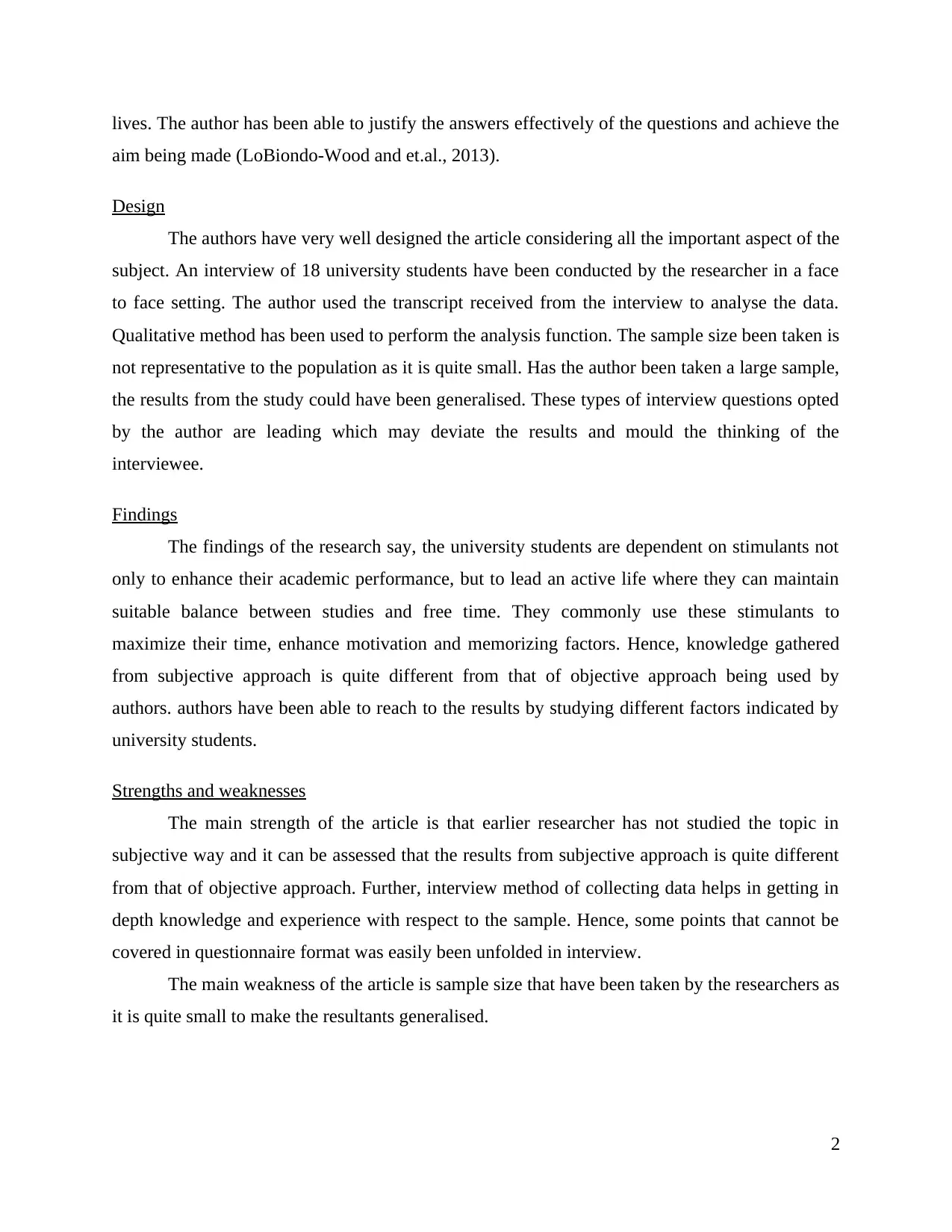
lives. The author has been able to justify the answers effectively of the questions and achieve the
aim being made (LoBiondo-Wood and et.al., 2013).
Design
The authors have very well designed the article considering all the important aspect of the
subject. An interview of 18 university students have been conducted by the researcher in a face
to face setting. The author used the transcript received from the interview to analyse the data.
Qualitative method has been used to perform the analysis function. The sample size been taken is
not representative to the population as it is quite small. Has the author been taken a large sample,
the results from the study could have been generalised. These types of interview questions opted
by the author are leading which may deviate the results and mould the thinking of the
interviewee.
Findings
The findings of the research say, the university students are dependent on stimulants not
only to enhance their academic performance, but to lead an active life where they can maintain
suitable balance between studies and free time. They commonly use these stimulants to
maximize their time, enhance motivation and memorizing factors. Hence, knowledge gathered
from subjective approach is quite different from that of objective approach being used by
authors. authors have been able to reach to the results by studying different factors indicated by
university students.
Strengths and weaknesses
The main strength of the article is that earlier researcher has not studied the topic in
subjective way and it can be assessed that the results from subjective approach is quite different
from that of objective approach. Further, interview method of collecting data helps in getting in
depth knowledge and experience with respect to the sample. Hence, some points that cannot be
covered in questionnaire format was easily been unfolded in interview.
The main weakness of the article is sample size that have been taken by the researchers as
it is quite small to make the resultants generalised.
2
aim being made (LoBiondo-Wood and et.al., 2013).
Design
The authors have very well designed the article considering all the important aspect of the
subject. An interview of 18 university students have been conducted by the researcher in a face
to face setting. The author used the transcript received from the interview to analyse the data.
Qualitative method has been used to perform the analysis function. The sample size been taken is
not representative to the population as it is quite small. Has the author been taken a large sample,
the results from the study could have been generalised. These types of interview questions opted
by the author are leading which may deviate the results and mould the thinking of the
interviewee.
Findings
The findings of the research say, the university students are dependent on stimulants not
only to enhance their academic performance, but to lead an active life where they can maintain
suitable balance between studies and free time. They commonly use these stimulants to
maximize their time, enhance motivation and memorizing factors. Hence, knowledge gathered
from subjective approach is quite different from that of objective approach being used by
authors. authors have been able to reach to the results by studying different factors indicated by
university students.
Strengths and weaknesses
The main strength of the article is that earlier researcher has not studied the topic in
subjective way and it can be assessed that the results from subjective approach is quite different
from that of objective approach. Further, interview method of collecting data helps in getting in
depth knowledge and experience with respect to the sample. Hence, some points that cannot be
covered in questionnaire format was easily been unfolded in interview.
The main weakness of the article is sample size that have been taken by the researchers as
it is quite small to make the resultants generalised.
2
Paraphrase This Document
Need a fresh take? Get an instant paraphrase of this document with our AI Paraphraser
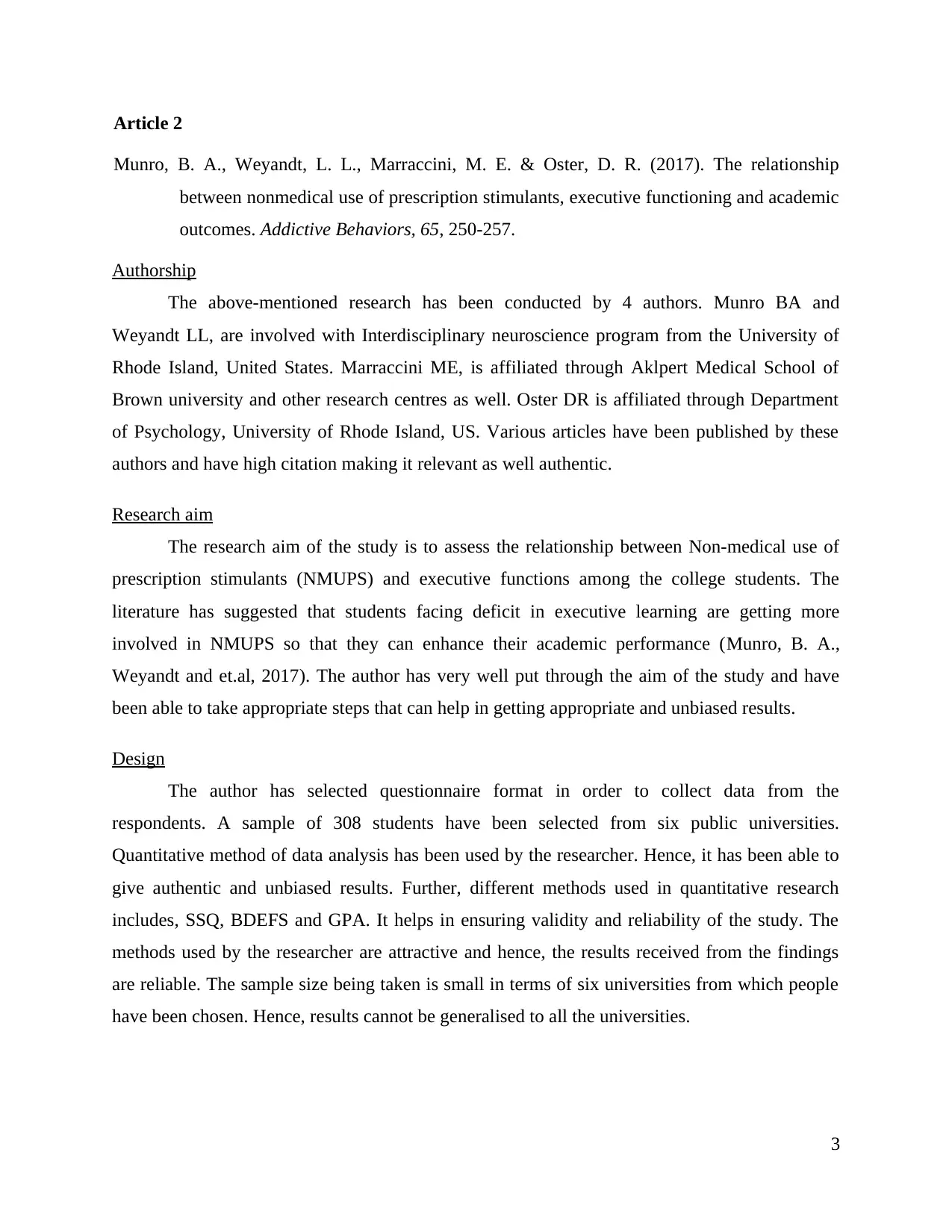
Article 2
Munro, B. A., Weyandt, L. L., Marraccini, M. E. & Oster, D. R. (2017). The relationship
between nonmedical use of prescription stimulants, executive functioning and academic
outcomes. Addictive Behaviors, 65, 250-257.
Authorship
The above-mentioned research has been conducted by 4 authors. Munro BA and
Weyandt LL, are involved with Interdisciplinary neuroscience program from the University of
Rhode Island, United States. Marraccini ME, is affiliated through Aklpert Medical School of
Brown university and other research centres as well. Oster DR is affiliated through Department
of Psychology, University of Rhode Island, US. Various articles have been published by these
authors and have high citation making it relevant as well authentic.
Research aim
The research aim of the study is to assess the relationship between Non-medical use of
prescription stimulants (NMUPS) and executive functions among the college students. The
literature has suggested that students facing deficit in executive learning are getting more
involved in NMUPS so that they can enhance their academic performance (Munro, B. A.,
Weyandt and et.al, 2017). The author has very well put through the aim of the study and have
been able to take appropriate steps that can help in getting appropriate and unbiased results.
Design
The author has selected questionnaire format in order to collect data from the
respondents. A sample of 308 students have been selected from six public universities.
Quantitative method of data analysis has been used by the researcher. Hence, it has been able to
give authentic and unbiased results. Further, different methods used in quantitative research
includes, SSQ, BDEFS and GPA. It helps in ensuring validity and reliability of the study. The
methods used by the researcher are attractive and hence, the results received from the findings
are reliable. The sample size being taken is small in terms of six universities from which people
have been chosen. Hence, results cannot be generalised to all the universities.
3
Munro, B. A., Weyandt, L. L., Marraccini, M. E. & Oster, D. R. (2017). The relationship
between nonmedical use of prescription stimulants, executive functioning and academic
outcomes. Addictive Behaviors, 65, 250-257.
Authorship
The above-mentioned research has been conducted by 4 authors. Munro BA and
Weyandt LL, are involved with Interdisciplinary neuroscience program from the University of
Rhode Island, United States. Marraccini ME, is affiliated through Aklpert Medical School of
Brown university and other research centres as well. Oster DR is affiliated through Department
of Psychology, University of Rhode Island, US. Various articles have been published by these
authors and have high citation making it relevant as well authentic.
Research aim
The research aim of the study is to assess the relationship between Non-medical use of
prescription stimulants (NMUPS) and executive functions among the college students. The
literature has suggested that students facing deficit in executive learning are getting more
involved in NMUPS so that they can enhance their academic performance (Munro, B. A.,
Weyandt and et.al, 2017). The author has very well put through the aim of the study and have
been able to take appropriate steps that can help in getting appropriate and unbiased results.
Design
The author has selected questionnaire format in order to collect data from the
respondents. A sample of 308 students have been selected from six public universities.
Quantitative method of data analysis has been used by the researcher. Hence, it has been able to
give authentic and unbiased results. Further, different methods used in quantitative research
includes, SSQ, BDEFS and GPA. It helps in ensuring validity and reliability of the study. The
methods used by the researcher are attractive and hence, the results received from the findings
are reliable. The sample size being taken is small in terms of six universities from which people
have been chosen. Hence, results cannot be generalised to all the universities.
3
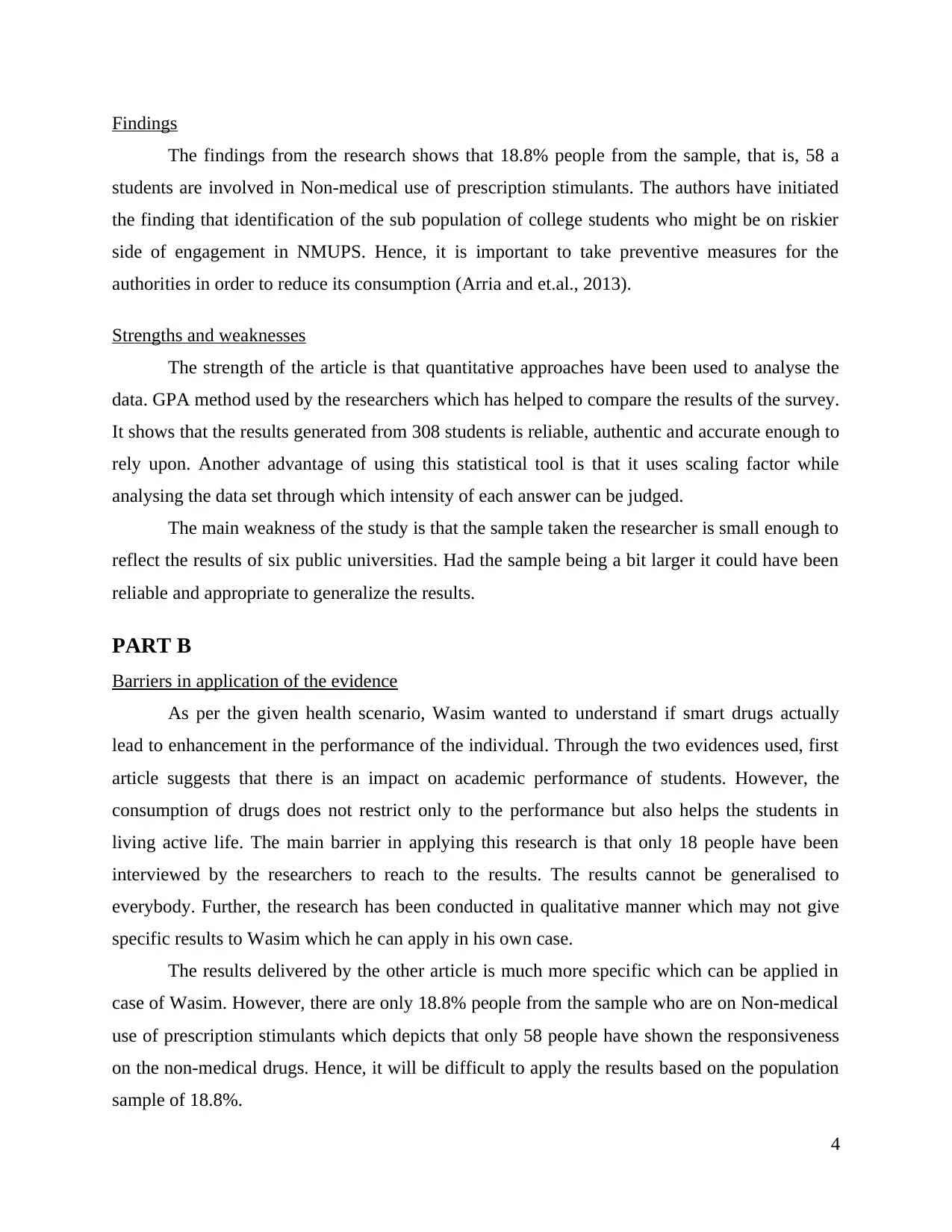
Findings
The findings from the research shows that 18.8% people from the sample, that is, 58 a
students are involved in Non-medical use of prescription stimulants. The authors have initiated
the finding that identification of the sub population of college students who might be on riskier
side of engagement in NMUPS. Hence, it is important to take preventive measures for the
authorities in order to reduce its consumption (Arria and et.al., 2013).
Strengths and weaknesses
The strength of the article is that quantitative approaches have been used to analyse the
data. GPA method used by the researchers which has helped to compare the results of the survey.
It shows that the results generated from 308 students is reliable, authentic and accurate enough to
rely upon. Another advantage of using this statistical tool is that it uses scaling factor while
analysing the data set through which intensity of each answer can be judged.
The main weakness of the study is that the sample taken the researcher is small enough to
reflect the results of six public universities. Had the sample being a bit larger it could have been
reliable and appropriate to generalize the results.
PART B
Barriers in application of the evidence
As per the given health scenario, Wasim wanted to understand if smart drugs actually
lead to enhancement in the performance of the individual. Through the two evidences used, first
article suggests that there is an impact on academic performance of students. However, the
consumption of drugs does not restrict only to the performance but also helps the students in
living active life. The main barrier in applying this research is that only 18 people have been
interviewed by the researchers to reach to the results. The results cannot be generalised to
everybody. Further, the research has been conducted in qualitative manner which may not give
specific results to Wasim which he can apply in his own case.
The results delivered by the other article is much more specific which can be applied in
case of Wasim. However, there are only 18.8% people from the sample who are on Non-medical
use of prescription stimulants which depicts that only 58 people have shown the responsiveness
on the non-medical drugs. Hence, it will be difficult to apply the results based on the population
sample of 18.8%.
4
The findings from the research shows that 18.8% people from the sample, that is, 58 a
students are involved in Non-medical use of prescription stimulants. The authors have initiated
the finding that identification of the sub population of college students who might be on riskier
side of engagement in NMUPS. Hence, it is important to take preventive measures for the
authorities in order to reduce its consumption (Arria and et.al., 2013).
Strengths and weaknesses
The strength of the article is that quantitative approaches have been used to analyse the
data. GPA method used by the researchers which has helped to compare the results of the survey.
It shows that the results generated from 308 students is reliable, authentic and accurate enough to
rely upon. Another advantage of using this statistical tool is that it uses scaling factor while
analysing the data set through which intensity of each answer can be judged.
The main weakness of the study is that the sample taken the researcher is small enough to
reflect the results of six public universities. Had the sample being a bit larger it could have been
reliable and appropriate to generalize the results.
PART B
Barriers in application of the evidence
As per the given health scenario, Wasim wanted to understand if smart drugs actually
lead to enhancement in the performance of the individual. Through the two evidences used, first
article suggests that there is an impact on academic performance of students. However, the
consumption of drugs does not restrict only to the performance but also helps the students in
living active life. The main barrier in applying this research is that only 18 people have been
interviewed by the researchers to reach to the results. The results cannot be generalised to
everybody. Further, the research has been conducted in qualitative manner which may not give
specific results to Wasim which he can apply in his own case.
The results delivered by the other article is much more specific which can be applied in
case of Wasim. However, there are only 18.8% people from the sample who are on Non-medical
use of prescription stimulants which depicts that only 58 people have shown the responsiveness
on the non-medical drugs. Hence, it will be difficult to apply the results based on the population
sample of 18.8%.
4
⊘ This is a preview!⊘
Do you want full access?
Subscribe today to unlock all pages.

Trusted by 1+ million students worldwide
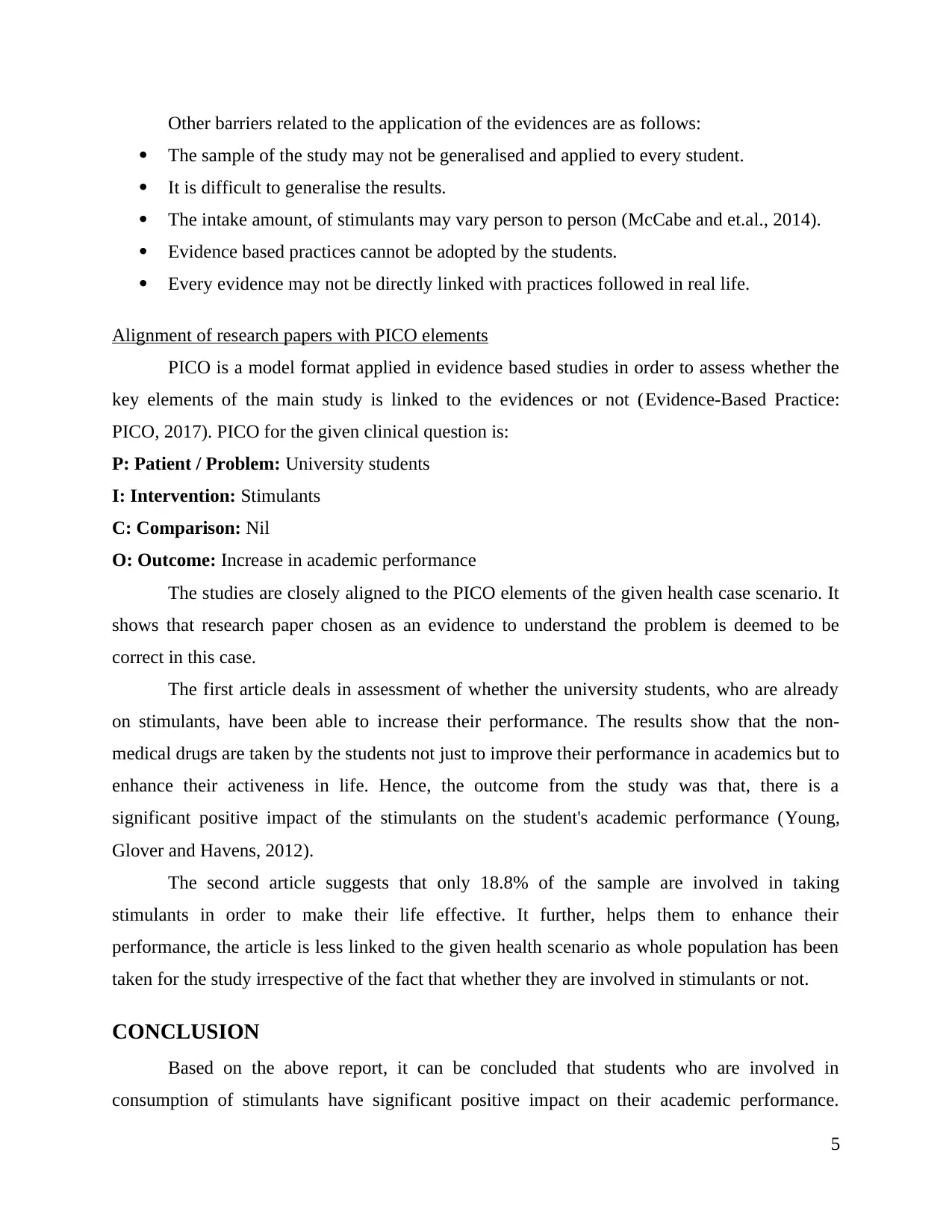
Other barriers related to the application of the evidences are as follows:
The sample of the study may not be generalised and applied to every student.
It is difficult to generalise the results.
The intake amount, of stimulants may vary person to person (McCabe and et.al., 2014).
Evidence based practices cannot be adopted by the students.
Every evidence may not be directly linked with practices followed in real life.
Alignment of research papers with PICO elements
PICO is a model format applied in evidence based studies in order to assess whether the
key elements of the main study is linked to the evidences or not (Evidence-Based Practice:
PICO, 2017). PICO for the given clinical question is:
P: Patient / Problem: University students
I: Intervention: Stimulants
C: Comparison: Nil
O: Outcome: Increase in academic performance
The studies are closely aligned to the PICO elements of the given health case scenario. It
shows that research paper chosen as an evidence to understand the problem is deemed to be
correct in this case.
The first article deals in assessment of whether the university students, who are already
on stimulants, have been able to increase their performance. The results show that the non-
medical drugs are taken by the students not just to improve their performance in academics but to
enhance their activeness in life. Hence, the outcome from the study was that, there is a
significant positive impact of the stimulants on the student's academic performance (Young,
Glover and Havens, 2012).
The second article suggests that only 18.8% of the sample are involved in taking
stimulants in order to make their life effective. It further, helps them to enhance their
performance, the article is less linked to the given health scenario as whole population has been
taken for the study irrespective of the fact that whether they are involved in stimulants or not.
CONCLUSION
Based on the above report, it can be concluded that students who are involved in
consumption of stimulants have significant positive impact on their academic performance.
5
The sample of the study may not be generalised and applied to every student.
It is difficult to generalise the results.
The intake amount, of stimulants may vary person to person (McCabe and et.al., 2014).
Evidence based practices cannot be adopted by the students.
Every evidence may not be directly linked with practices followed in real life.
Alignment of research papers with PICO elements
PICO is a model format applied in evidence based studies in order to assess whether the
key elements of the main study is linked to the evidences or not (Evidence-Based Practice:
PICO, 2017). PICO for the given clinical question is:
P: Patient / Problem: University students
I: Intervention: Stimulants
C: Comparison: Nil
O: Outcome: Increase in academic performance
The studies are closely aligned to the PICO elements of the given health case scenario. It
shows that research paper chosen as an evidence to understand the problem is deemed to be
correct in this case.
The first article deals in assessment of whether the university students, who are already
on stimulants, have been able to increase their performance. The results show that the non-
medical drugs are taken by the students not just to improve their performance in academics but to
enhance their activeness in life. Hence, the outcome from the study was that, there is a
significant positive impact of the stimulants on the student's academic performance (Young,
Glover and Havens, 2012).
The second article suggests that only 18.8% of the sample are involved in taking
stimulants in order to make their life effective. It further, helps them to enhance their
performance, the article is less linked to the given health scenario as whole population has been
taken for the study irrespective of the fact that whether they are involved in stimulants or not.
CONCLUSION
Based on the above report, it can be concluded that students who are involved in
consumption of stimulants have significant positive impact on their academic performance.
5
Paraphrase This Document
Need a fresh take? Get an instant paraphrase of this document with our AI Paraphraser

Further, the evidences being taken by Wasim, in order to create evidence based study are quite
linked to the research topic. Further, the results of the studies are authentic and reliable. Further,
first article as applied qualitative and other has applied quantitative approach to analyse the data
set. In addition to this, PICO of the research question is closely linked to the different aspect of
the two-evidence selected to reach to the conclusion.
6
linked to the research topic. Further, the results of the studies are authentic and reliable. Further,
first article as applied qualitative and other has applied quantitative approach to analyse the data
set. In addition to this, PICO of the research question is closely linked to the different aspect of
the two-evidence selected to reach to the conclusion.
6
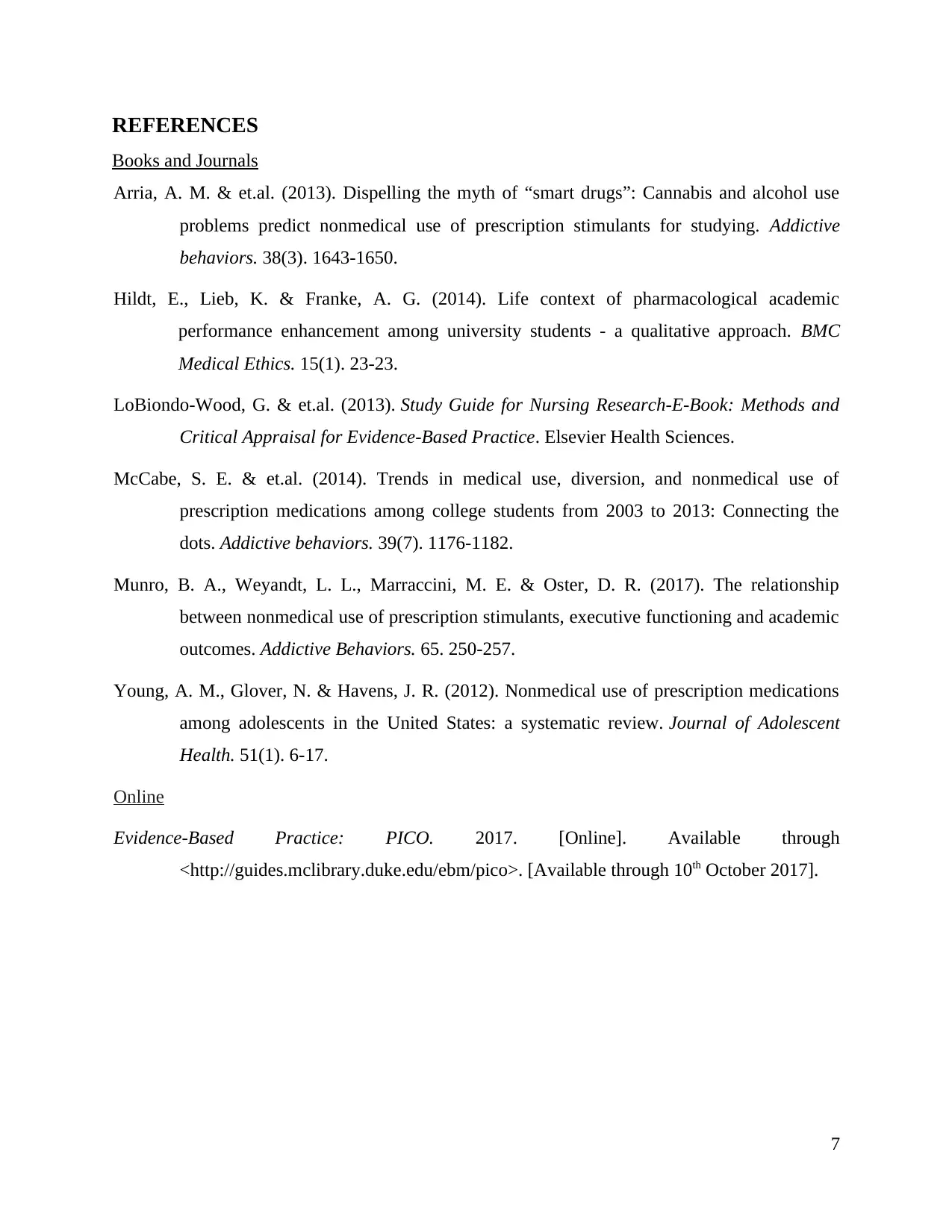
REFERENCES
Books and Journals
Arria, A. M. & et.al. (2013). Dispelling the myth of “smart drugs”: Cannabis and alcohol use
problems predict nonmedical use of prescription stimulants for studying. Addictive
behaviors. 38(3). 1643-1650.
Hildt, E., Lieb, K. & Franke, A. G. (2014). Life context of pharmacological academic
performance enhancement among university students - a qualitative approach. BMC
Medical Ethics. 15(1). 23-23.
LoBiondo-Wood, G. & et.al. (2013). Study Guide for Nursing Research-E-Book: Methods and
Critical Appraisal for Evidence-Based Practice. Elsevier Health Sciences.
McCabe, S. E. & et.al. (2014). Trends in medical use, diversion, and nonmedical use of
prescription medications among college students from 2003 to 2013: Connecting the
dots. Addictive behaviors. 39(7). 1176-1182.
Munro, B. A., Weyandt, L. L., Marraccini, M. E. & Oster, D. R. (2017). The relationship
between nonmedical use of prescription stimulants, executive functioning and academic
outcomes. Addictive Behaviors. 65. 250-257.
Young, A. M., Glover, N. & Havens, J. R. (2012). Nonmedical use of prescription medications
among adolescents in the United States: a systematic review. Journal of Adolescent
Health. 51(1). 6-17.
Online
Evidence-Based Practice: PICO. 2017. [Online]. Available through
<http://guides.mclibrary.duke.edu/ebm/pico>. [Available through 10th October 2017].
7
Books and Journals
Arria, A. M. & et.al. (2013). Dispelling the myth of “smart drugs”: Cannabis and alcohol use
problems predict nonmedical use of prescription stimulants for studying. Addictive
behaviors. 38(3). 1643-1650.
Hildt, E., Lieb, K. & Franke, A. G. (2014). Life context of pharmacological academic
performance enhancement among university students - a qualitative approach. BMC
Medical Ethics. 15(1). 23-23.
LoBiondo-Wood, G. & et.al. (2013). Study Guide for Nursing Research-E-Book: Methods and
Critical Appraisal for Evidence-Based Practice. Elsevier Health Sciences.
McCabe, S. E. & et.al. (2014). Trends in medical use, diversion, and nonmedical use of
prescription medications among college students from 2003 to 2013: Connecting the
dots. Addictive behaviors. 39(7). 1176-1182.
Munro, B. A., Weyandt, L. L., Marraccini, M. E. & Oster, D. R. (2017). The relationship
between nonmedical use of prescription stimulants, executive functioning and academic
outcomes. Addictive Behaviors. 65. 250-257.
Young, A. M., Glover, N. & Havens, J. R. (2012). Nonmedical use of prescription medications
among adolescents in the United States: a systematic review. Journal of Adolescent
Health. 51(1). 6-17.
Online
Evidence-Based Practice: PICO. 2017. [Online]. Available through
<http://guides.mclibrary.duke.edu/ebm/pico>. [Available through 10th October 2017].
7
⊘ This is a preview!⊘
Do you want full access?
Subscribe today to unlock all pages.

Trusted by 1+ million students worldwide
1 out of 9
Related Documents
Your All-in-One AI-Powered Toolkit for Academic Success.
+13062052269
info@desklib.com
Available 24*7 on WhatsApp / Email
![[object Object]](/_next/static/media/star-bottom.7253800d.svg)
Unlock your academic potential
Copyright © 2020–2025 A2Z Services. All Rights Reserved. Developed and managed by ZUCOL.





